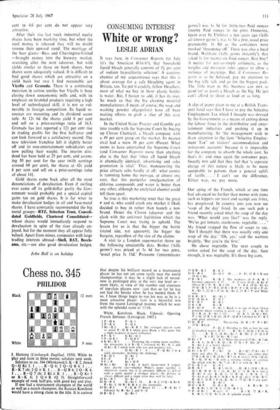White or wrong?
CONSUMING INTEREST
LESLIE ADRIAN
It says here, in Consumer Reports for July (it's the American Which?), that 'household liquid bleach generally consists of 51 per cent of sodium hypochlorite solution.' A cautious chemist of my acquaintance says that this is about average for a safe bleaching agent in Britain, too. To put it crudely, fellow bleachers, most of what we buy in those plastic bottles is water. But, I hasten to add, it has its uses. So much so that the big cleaning material manufacturers (I mean, of course, the soap and washing powder oligopolists) have all been making efforts to grab a slice of this easy market.
In the United States Procter and Gamble got into trouble with the Supreme Court by buying up Clorox Chemical, a bleach company with a 49 per cent grasp on the market. Its nearest rival had a mere 16 per cent (Purex). What seems to have entertained the Supreme Court (and Consumer Reports) more than anything else is the fact that 'since all liquid bleach is chemically identical, advertising and sales promotion is vital.' Thus, manoeuvring the price attracts sales hardly at all : what counts is ramming home the message, at almost any cost, that this particular amalgamation of chlorine compounds and water is better than any other, although no analytical chemist could tell them apart.
So true is this marketing tenet that the great P and o, who could crash any market it liked, decided to buy in rather than launch a new brand. Hence the Clorox takeover and the clash with the anti-trust legislation which the Supreme Court was trying to uphold. The lesson for us is that the bigger the bottle (stated size, not apparent), the bigger the bargain, regardless of the size of the claims.
A visit to a London supermarket threw up the following unscientific data. Brobat germs') was priced at Is 4d for two pints, 'usual price Is ltd.' Parazone ('exterminates
germs) was Is 3d for thirty-two fluid ounces (twenty fluid ounces to the pint). Domestos, taken over by Unilever a few years ago ('kills all known germs'), was Is 5d a pint, usual price presumably Is 8d as the containers were marked 'threepence off.' There was also a local brand, Waltham ('kills germs instantly'), that asked Is for twenty-six fluid ounces. Best buy? A matter for not-so-simple arithmetic, as the weights and measures rules appear to allow a manage of markings. But, if Consumer Re- ports is to be believed, pay no attention to the big telly talk and go for the biggest pack. The little man in this business can mix as good (or as poor) a bleach as the big. He just can't afford to shout as loud or as long.
A slip of paper given to me at a British Trans- port hotel says that I have to pay the Selective Employment Tax which I thought was devised by the Government as a means of cutting down the labour force in the distributive and enter- tainment industries and pushing it up in manufacturing. So 'the management wish to draw attention to the item "Selective Employ- ment Tax" on visitors' accommodation and restaurant accounts' because it is impossible for the company to absorb the whole cost. So that's it : and once again the consumer pays. Sweetly 13Th add that they feel that 'a separate charge of this nature is likely to be more acceptable to patrons than a general uplift
of tariffs. . .' I can't see the difference. Either way, we pay more.
Our aping of the French, which at one time had advanced no further than menus with items such as kippers sur toast and scampi aux frites, has progressed. In country inns you now see 'soup of the day' listed. In one such pub a friend recently asked what the soup of the day was. 'What would you like?' was the reply. 'We've got tomato, mushroom, vegetable. ... ' My friend stopped the flow of soups to say, 'But I thought that there was usually only one soup of the day."Oh, yes,' said the waitress brightly, 'But you're the first.'
He chose vegetable. The next couple to arrive asked for the soup of the day. Sure enough, it was vegetable. It's those big cans.






























 Previous page
Previous page